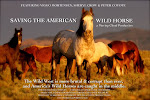- ALERT! ~ Patricia Fazio of the Wyoming Animal Welfare Network has recently issued an alert about a bill floating around the U.S. House, H.R. 767 - the Refuge Ecology Protection, Assistance, and Immediate Response Act, that aims to target the eradication of any species classified as a "harmful non-native" on federal wildlife refuges and private lands, potentially leaving hundreds of animal and plant species subject to wholesale slaughter, including wild horses and burros not protected under the Wild Free-Roaming Horse and Burro Act.
Follow up on the bills status has revealed that it sailed through the House without opposition and now sits in the Senate Committee on Environment and Public Works of which Senator Barbara Boxer of California is Chair. If passed, this bill could effectively be used on the Sheldon wild horses and burros and could have massive repercussions to wild horses and burros everywhere including all public land managed by National Park Service, United States Fish & Wildlife Service and of course state managed lands as well such as Big Bend State Park in Texas. Wild Horse & Burro advocates better pay attention to this or they may find themselves up a creek with no paddle!
The source of the alert comes from an organization called Alley Cat Allies as "feral cats" may also be targeted for elimination. Click Here to read their report and stay abreast of the latest developments and possible actions needed or check with The Library of Congress' website (Click Here) and type in the bill number in the search engine.- The Humane Society of the United States has posted their 2007 Congressional Scorecard on those who supported humane standards and animal rights. Click Here to see where your Representatives stand.
- Read the Lovell Chronicles story on new film techniques being used to reveal the intimate world of the Pryor Mountain wild horses. Interview with Ginger Kathrens of the Cloud Foundation. Click Here to learn more.
- Twenty-five horse trainers are needed for the Wyoming Mustang Challenge to be held in conjunction with the Wyoming State Fair on August 15-16. Click Here to learn more.
- Team Barbaro of Wisconsin do a great job highlighting both the commitment and activism of Phantom Stallion author Terri Farley and her young fans dedicated to helping and saving horses everywhere. Click Here to learn more.
- Rancher Steve Edwards works on breeding the Corolla wild horses due to grave concerns that this extremely pure strain of Spanish Mustang is being "managed to extinction" by the low population levels that have been established. Click Here to learn more.
- "A Donkey's Tale" recounts the story of a local rural community getting hit by "urbanization" when a donkey's braying is determined by the courts to be a nuisance. Long-time residents were stunned and began to wonder what was next - peacocks? roosters? sheep? See what they are trying to do about it and how they are trying to preserve a fast disappearing way of life. Click Here to learn more.
- While this article focuses on the recent exposure of the inhumane and dangerous slaughter practices uncovered recently by the Humane Society of the United States that included downer cows and the 143 million pounds of beef recalled, the statistics and quotes regarding the complete lack of sincere supervision - towards our food and the animals being used for it - echos many of the same truths exposed in the horse slaughter industry. Click Here to learn more.


